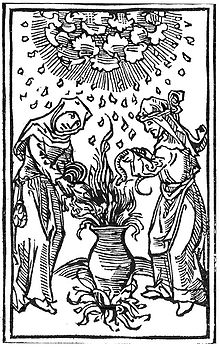
Akelarre is the Basque term meaning Witches' Sabbath (the place where witches hold their meetings). Akerra means male goat in the Basque language. Witches' sabbaths were envisioned as presided over by a goat.
The word has been loaned to Castilian Spanish (which uses the spelling Aquelarre). It has been used in Castilian Spanish since the witch trials of the 17th century. The word is most famous as the title of the witchcraft painting by Goya in the Museo del Prado, which depicts witches in the company of a huge male goat.

The most common etymology proposed is that meaning meadow (larre) of the male goat (aker "buck, billy goat"). The Spanish Inquisition accused people of worshipping a black goat, related to the worship of Satan. An alternative explanation could be that it originally was alkelarre, alka being a local name for the herb Dactylis hispanica. In this case, the first etymology would have been a manipulation of the Inquisition,[1] the fact being that the Basques did not know during the 1609-1612 persecution period or later what the "akelarre" referred to by the inquisitors meant. The word "aquelarre" is first attested in 1609 in a Spanish-language inquisitorial briefing, as synonym to junta diabólica, meaning 'diabolic assembly'. Basque terms, transcribed into Spanish texts often by monolingual Spanish-language copyists, were fraught with mistakes.
Nevertheless, the black he-Goat or Akerbeltz is known in Basque mythology to be an attribute of goddess Mari and is found in a Roman-age slab as a votive dedication: Aherbelts Deo ("to the god Aherbelts") (see: Aquitanian language)..

Other expressive names used for sabbat meeting places in Basque culture include:
From the point of view of anthropology, akelarres would be the remains of pagan rites that were celebrated in clandestinity due to its banning by religious authorities at that time.
Although some say the first Akelarres were held in Classical Greece when women, naked and drunk, went up the mountain to celebrate parties without men, this identification is wrong, since they worshipped the God Dionysus and they were not witches.
Gossip about sorcerers' meetings spread in the Middle Ages. However, they probably referred to common women who had knowledge on properties of medicinal herbs. The herb Atropa belladonna has had an important meaning in the legend and symbology of the Akelarre.
Hallucinogens were commonly used during the rite in order to achieve ecstasy. It was dangerous to calculate the right dose when the used quantities approached the lethal quantity, and that is why some substances started being applied as an ointment in the vagina or in the anus. This could have given rise to notions of a sexual element in witch practices and/or the use of cauldrons to prepare magic potions and salves . It is possible that the ointment was applied to the vagina with a staff and this might explain the frequent depiction of witches as flying with a broomstick between their legs.[citation needed] Some species of toad are poisonous if they come in contact with human skin. The toad's skin is also a hallucinogen, and they also appear in popular beliefs. The same could happen with poisonous mushrooms, such as amanita muscaria.[citation needed]
In 1610, the Spanish Inquisition tribunal of Logroño initiated a large witch-hunt in Zugarramurdi and villages around Navarre that resulted in 300 people being accused of practising witchcraft. They took 40 of them to Logroño and burnt at the stake 12 supposed witches in Zugarramurdi (5 of them symbolically, as they had been killed by torture earlier). Julio Caro Baroja in his book The World of the Witches explains that Basque witchcraft is known due to this witch-hunt, being one of the most infamous between the European witch-hunts. It was possibly as a result of these major trials that the term akelarre became synonymous with the word "witch's sabbath" and spread into common parlance in both Basque and Spanish.
While previous study of the Zugarramurdi trials has focused on the mechanics of persecution, more recent analysis by Emma Wilby has explored how the suspects themselves brought a wide range of belief and experience to their descriptions of the akelarre, from folk magical practices, communal medicine-making and confraternal meetings to popular expressions of Catholic religious ritual and theatre such as liturgical misrule and cursing masses.[2]
Similar celebrations spread over the Pyrenees mountains in the Basque Country, Aragon, Catalonia and Occitania. Shepherds brought these beliefs on the way of their annual migration of sheep (transhumance) from mountains to the flatlands.